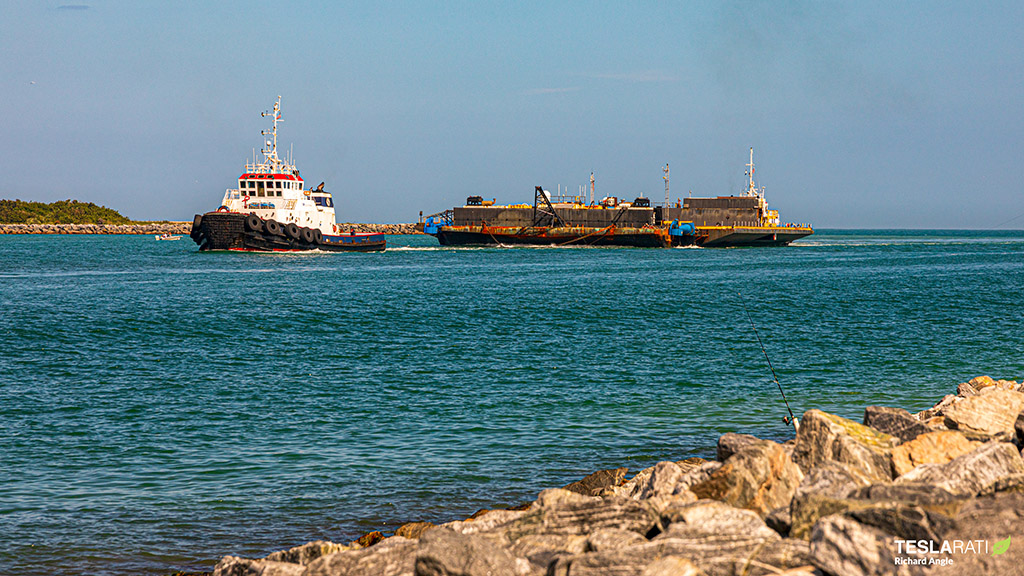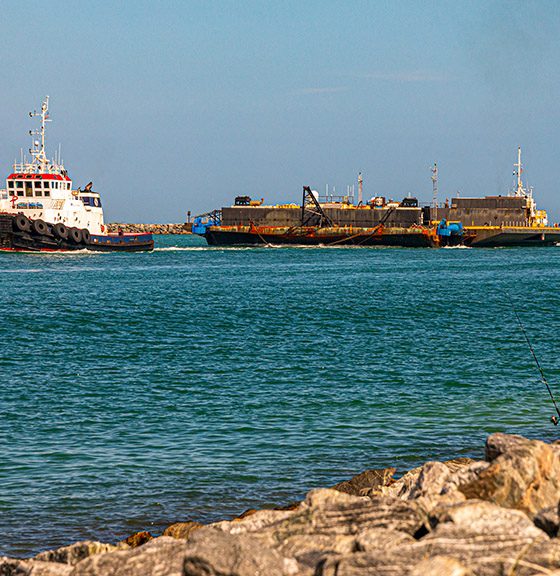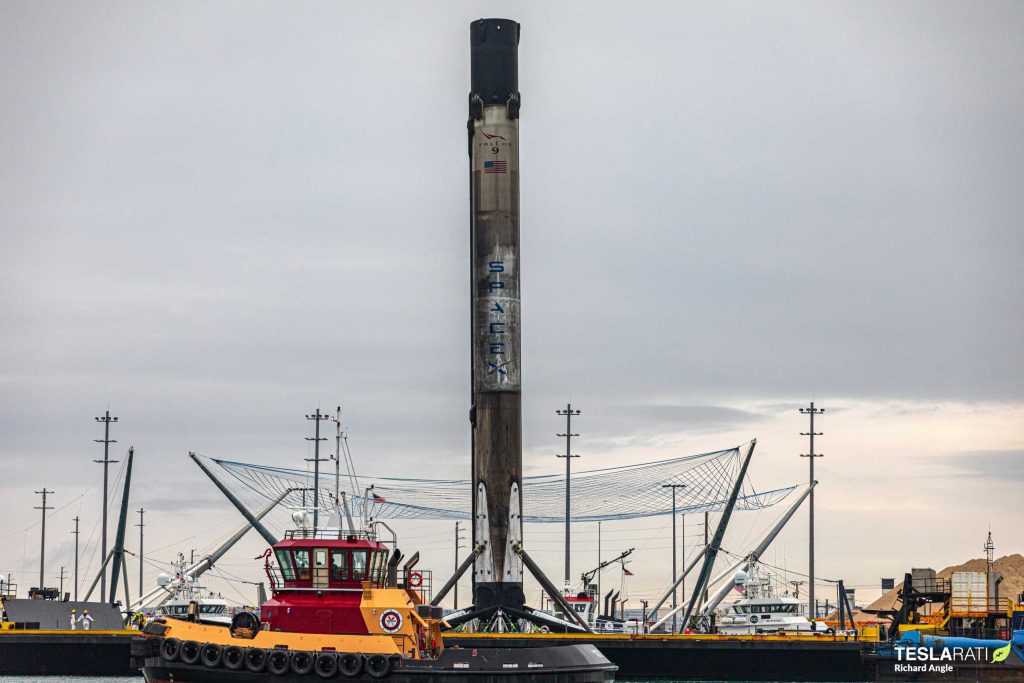

News
SpaceX readies for astronaut capsule recovery backup plan as rocket drone ship deploys to landing zone
Mission objectives of the SpaceX Crew Dragon Demo-2 test flight, have already commenced days ahead of the scheduled launch attempt. On Wednesday, May 27th at 4:33 pm EDT, Elon Musk’s rocket launching – and landing – company, SpaceX, will set out to achieve more firsts than it has ever attempted in one launch. The final Crew Dragon test flight will shuttle NASA astronauts Bob Behnken and Doug Hurley to the International Space Station for the very first time. Along with the primary mission objective to deliver the astronauts safely, many secondary objectives are built into the mission profile. One of which is autonomously turning the Falcon 9 booster around shortly after launch to land on a floating barge in the middle of the Atlantic Ocean.
During the late hours of Saturday, May 23rd, a trusted veteran member of the SpaceX fleet of recovery vessels, Tug Hawk, returned to Port Canaveral to transport SpaceX’s autonomous spaceport drone ship, Of Course I Still Love You (OCISLY) to the designated booster recovery zone some 510km downrange. It seems that Tug Hawk and its crew returned specifically to assist with the recovery efforts of SpaceX’s highest-profile launch to date as there was already another tug at Port Canaveral available to assist that was not used. The arrival was captured by long-time port activity documenter, Julia Bergeron, and reported by the unofficial Twitter SpaceX recovery vessel tracking account, SpaceXFleet.
The SpaceX recovery fleet portion of the Demo-2 mission got underway on the morning of Sunday (May 24th). Space Coast local Greg Scott was at Port Canaveral to capture Tug Hawk’s departure with OCISLY in tow just twelve hours after arriving. About an hour later, the OCISLY support vessel that carries cargo and crew essential for booster recovery efforts, GO Quest, departed. It will take Tug Hawk and OCISLY approximately two days to travel to the recovery zone, arriving about 24 hours before the launch attempt.
The propulsive landing of a booster at sea is not a new concept for SpaceX. However, it is a practice that can be somewhat tricky to get right every time due to a multitude of factors. Recently, SpaceX suffered the loss of the Falcon 9 boosters B1056 and B1048 following recent Starlink satellite launches. Both boosters suffered unrelated issues with high winds and software glitches resulting in failed attempts to stick the landing on OCISLY. However, SpaceX successfully demonstrated the reliability of the Falcon 9 landing capability with the flawless launch and landing of the April 22nd Starlink Falcon 9 B1051 booster.

A special circumstance of the Demo-2 mission is the added recovery requirements of the Crew Dragon capsule. With Crew Dragon launching from LC-39A at the Kennedy Space Center in Florida and splashdown designated for the Atlantic Ocean, various recovery zones span almost the entire length of the United States’ eastern seaboard and across the Atlantic Ocean to Ireland. Special recovery zones also are located throughout the Gulf of Mexico.
Typically, the recovery of a crew capsule would only be thought to occur upon mission end when it is on approach for splashdown after re-entry. However, the specially equipped SpaceX Crew Dragon recovery vessels, GO Searcher and GO Navigator, are required to be able to respond to a number of locations during launch and through the entire duration of Crew Dragon’s time on orbit chasing down the International Space Station prior to docking – for Demo-2 that will be nineteen hours. This is to ensure that in the unlikely event of Crew Dragon experiencing an emergency pad or launch abort scenario, the crew aboard can be safely rescued.
To this end, GO Searcher departed Port Canaveral days ago destined for the Naval Air Station in Pensacola on Florida’s west coast. GO Navigator will remain at Port Canaveral until Crew Dragon returns for a splashdown following the conclusion of Demo-2. Dual Dragon recovery vessels stationed on either side of Florida ensures that Hurley and Behnken can be rescued should they require emergency recovery.
Should Demo-2 pass SpaceX’s upcoming final Launch Readiness Review scheduled for Monday, May 25th, all will proceed toward the launch attempt on Wednesday, May 27th at 4:33 pm EDT.
Check out Teslarati’s newsletters for prompt updates, on-the-ground perspectives, and unique glimpses of SpaceX’s rocket launch and recovery processes.

Elon Musk
Elon Musk’s X will start using a Tesla-like software update strategy
The initiative seems designed to accelerate updates to the social media platform, while maintaining maximum transparency.

Elon Musk’s social media platform X will adopt a Tesla-esque approach to software updates for its algorithm.
The initiative seems designed to accelerate updates to the social media platform, while maintaining maximum transparency.
X’s updates to its updates
As per Musk in a post on X, the social media company will be making a new algorithm to determine what organic and advertising posts are recommended to users. These updates would then be repeated every four weeks.
“We will make the new 𝕏 algorithm, including all code used to determine what organic and advertising posts are recommended to users, open source in 7 days. This will be repeated every 4 weeks, with comprehensive developer notes, to help you understand what changed,” Musk wrote in his post.
The initiative somewhat mirrors Tesla’s over-the-air update model, where vehicle software is regularly refined and pushed to users with detailed release notes. This should allow users to better understand the details of X’s every update and foster a healthy feedback loop for the social media platform.
xAI and X
X, formerly Twitter, has been acquired by Elon Musk’s artificial intelligence startup, xAI last year. Since then, xAI has seen a rapid rise in valuation. Following the company’s the company’s upsized $20 billion Series E funding round, estimates now suggest that xAI is worth tens about $230 to $235 billion. That’s several times larger than Tesla when Elon Musk received his controversial 2018 CEO Performance Award.
As per xAI, the Series E funding round attracted a diverse group of investors, including Valor Equity Partners, Stepstone Group, Fidelity Management & Research Company, Qatar Investment Authority, MGX, and Baron Capital Group, among others. Strategic partners NVIDIA and Cisco Investments also continued support for building the world’s largest GPU clusters.
News
Tesla FSD Supervised wins MotorTrend’s Best Driver Assistance Award
The decision marks a notable reversal for the publication from prior years, with judges citing major real-world improvements that pushed Tesla’s latest FSD software ahead of every competing ADAS system.

Tesla’s Full Self-Driving (Supervised) system has been named the best driver-assistance technology on the market, earning top honors at the 2026 MotorTrend Best Tech Awards.
The decision marks a notable reversal for the publication from prior years, with judges citing major real-world improvements that pushed Tesla’s latest FSD software ahead of every competing ADAS system. And it wasn’t even close.
MotorTrend reverses course
MotorTrend awarded Tesla FSD (Supervised) its 2026 Best Tech Driver Assistance title after extensive testing of the latest v14 software. The publication acknowledged that it had previously criticized earlier versions of FSD for erratic behavior and near-miss incidents, ultimately favoring rivals such as GM’s Super Cruise in earlier evaluations.
According to MotorTrend, the newest iteration of FSD resolved many of those shortcomings. Testers said v14 showed far smoother behavior in complex urban scenarios, including unprotected left turns, traffic circles, emergency vehicles, and dense city streets. While the system still requires constant driver supervision, judges concluded that no other advanced driver-assistance system currently matches its breadth of capability.
Unlike rival systems that rely on combinations of cameras, radar, lidar, and mapped highways, Tesla’s FSD operates using a camera-only approach and is capable of driving on city streets, rural roads, and freeways. MotorTrend stated that pure utility, the ability to handle nearly all road types, ultimately separated FSD from competitors like Ford BlueCruise, GM Super Cruise, and BMW’s Highway Assistant.
High cost and high capability
MotorTrend also addressed FSD’s pricing, which remains significantly higher than rival systems. Tesla currently charges $8,000 for a one-time purchase or $99 per month for a subscription, compared with far lower upfront and subscription costs from other automakers. The publication noted that the premium is justified given FSD’s unmatched scope and continuous software evolution.
Safety remained a central focus of the evaluation. While testers reported collision-free operation over thousands of miles, they noted ongoing concerns around FSD’s configurable driving modes, including options that allow aggressive driving and speeds beyond posted limits. MotorTrend emphasized that, like all Level 2 systems, FSD still depends on a fully attentive human driver at all times.
Despite those caveats, the publication concluded that Tesla’s rapid software progress fundamentally reshaped the competitive landscape. For drivers seeking the most capable hands-on driver-assistance system available today, MotorTrend concluded Tesla FSD (Supervised) now stands alone at the top.
News
Elon Musk’s Grokipedia surges to 5.6M articles, almost 79% of English Wikipedia
The explosive growth marks a major milestone for the AI-powered online encyclopedia, which was launched by Elon Musk’s xAI just months ago.

Elon Musk’s Grokipedia has grown to an impressive 5,615,201 articles as of today, closing in on 79% of the English Wikipedia’s current total of 7,119,376 articles.
The explosive growth marks a major milestone for the AI-powered online encyclopedia, which was launched by Elon Musk’s xAI just months ago. Needless to say, it would only be a matter of time before Grokipedia exceeds English Wikipedia in sheer volume.
Grokipedia’s rapid growth
xAI’s vision for Grokipedia emphasizes neutrality, while Grok’s reasoning capabilities allow for fast drafting and fact-checking. When Elon Musk announced the initiative in late September 2025, he noted that Grokipedia would be an improvement to Wikipedia because it would be designed to avoid bias.
At the time, Musk noted that Grokipedia “is a necessary step towards the xAI goal of understanding the Universe.”
Grokipedia was launched in late October, and while xAI was careful to list it only as Version 0.1 at the time, the online encyclopedia immediately earned praise. Wikipedia co-founder Larry Sanger highlighted the project’s innovative approach, noting how it leverages AI to fill knowledge gaps and enable rapid updates. Netizens also observed how Grokipedia tends to present articles in a more objective manner compared to Wikipedia, which is edited by humans.
Elon Musk’s ambitious plans
With 5,615,201 total articles, Grokipedia has now grown to almost 79% of English Wikipedia’s article base. This is incredibly quick, though Grokipedia remains text-only for now. xAI, for its part, has now updated the online encyclopedia’s iteration to v0.2.
Elon Musk has shared bold ideas for Grokipedia, including sending a record of the entire knowledge base to space as part of xAI’s mission to preserve and expand human understanding. At some point, Musk stated that Grokipedia will be renamed to Encyclopedia Galactica, and it will be sent to the cosmos.
“When Grokipedia is good enough (long way to go), we will change the name to Encyclopedia Galactica. It will be an open source distillation of all knowledge, including audio, images and video. Join xAI to help build the sci-fi version of the Library of Alexandria!” Musk wrote, adding in a later post that “Copies will be etched in stone and sent to the Moon, Mars and beyond. This time, it will not be lost.”








